The Leney Family
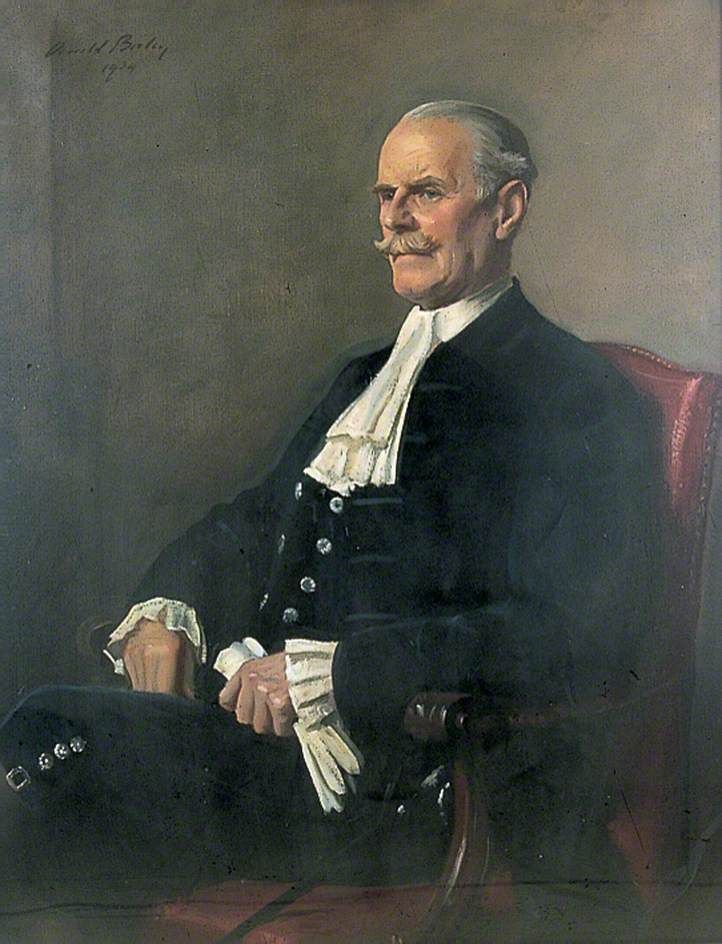 |
|
Alfred Charles Leney
Painting by Oswald Hornby Joseph Birley
|
Alfred Charles Leney
28 August 1860, in Dover, Kent,
England
21 September 1860, in St James,
Dover, Kent, England
Alfred Leney
Catherine (Fremlin) Leney
Bertha
Backhouse Hulke on 27 October 1887, in St Andrew, Deal, Kent, England
Alfred Charles Leney is recorded as a bachelor, aged 27, living in Buckland.
He is the son of Alfred Leney, brewer. Bertha Backhouse Hulke is recorded as
a spinster, aged 22, living in Deal. She is the daughter of Frederick Thomas
Hulke, Bachelor of Medicine. The marriage was witnessed by Harry Leney,
Lewis L. B. Hulke and Charlotte Hulke
Canterbury Journal, Kentish Times and Farmers'
Gazette 5 November 1887
27th Oct, at St Andrew’s, Deal, Alfred Charles
(Fred), eldest son of Alfred Leney, Esq., of Buckland House, Dover, to
Bertha Backhouse, third daughter of the late Frederick Thomas Hulke, M.B.
Lond., Admiralty House, Deal.
Dover
Express and East Kent News Friday 4 November 1887
MARRIAGE OF MR A. C. LENEY
On Thursday a large congregation assembled at St. Andrew’s Deal, to
witness the marriage of Miss. Bertha Backhouse Hulke, third daughter of
the late Frederick Thomas Hulke, M.B., Lond., of Admiralty House, Deal, to
Mr. A. C. Leney of Buckland House, Dover. The ceremony, which was choral,
was performed by the Rev. C. E. S. Woolmer, Vicar of Sidcup, assisted by
the Rev. R. Patterson, Rector of St. Andrew’s. The bride, who was attired
in an exquisite gown of rich white satin with court train, pearl
ornaments, and passementerie, and a long tulle veil, carried a bouquet of
gardenias, stephanotis, and other white flowers, and wore a gold bangle
with a diamond horseshoe, both the gift of the bridegroom. The bride was
given away by her brother, Mr. Lewis I. B. Hulke, (the Buffs); her
bridesmaids were her four sisters, the Misses Edith, Mabel, Dora and
Jessie Hulke, and Miss Florence Leney, sister of the bridegroom. They wore
stylish gowns of white Indian silk and gold braid, and white straw sailor
hats trimmed with white ribbon and tulle; each carried a handsome bouquet
of white and yellow flowers, and wore a gold bangle with horseshoe of
pearls, the gifts of the bridegroom. Mr. Henry Leney, brother of the
bridegroom, acted as best man. The presents, which were very numerous and
costly, included a case of nut crackers and plated tea-caddy, from the
servants of Admiralty House, plaited marmalade jars and cruet from the
servants at Buckland House, a Wedgewood afternoon tea service and a pair
of Golconds ware vases, from Mr. Leney’s Dover employees, silver
cigar-case from Mr. Leney’s London staff, and salt cellars from one of
their old servants.
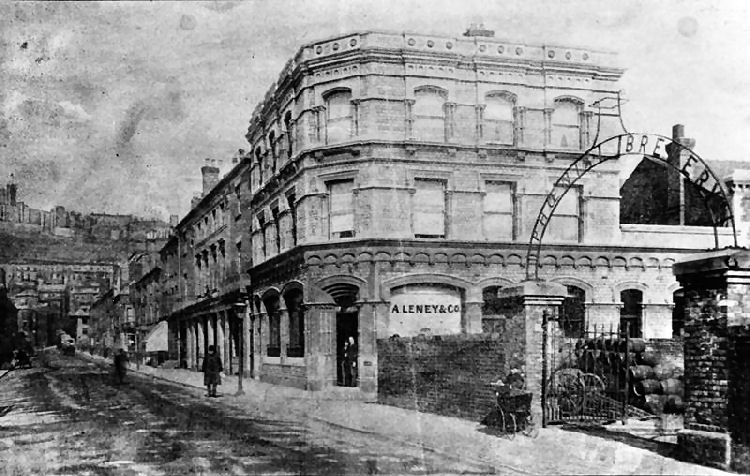 |
|
Leney's Phoenix Brewery, in Dolphin Lane,
Dover, Kent, c1890
|
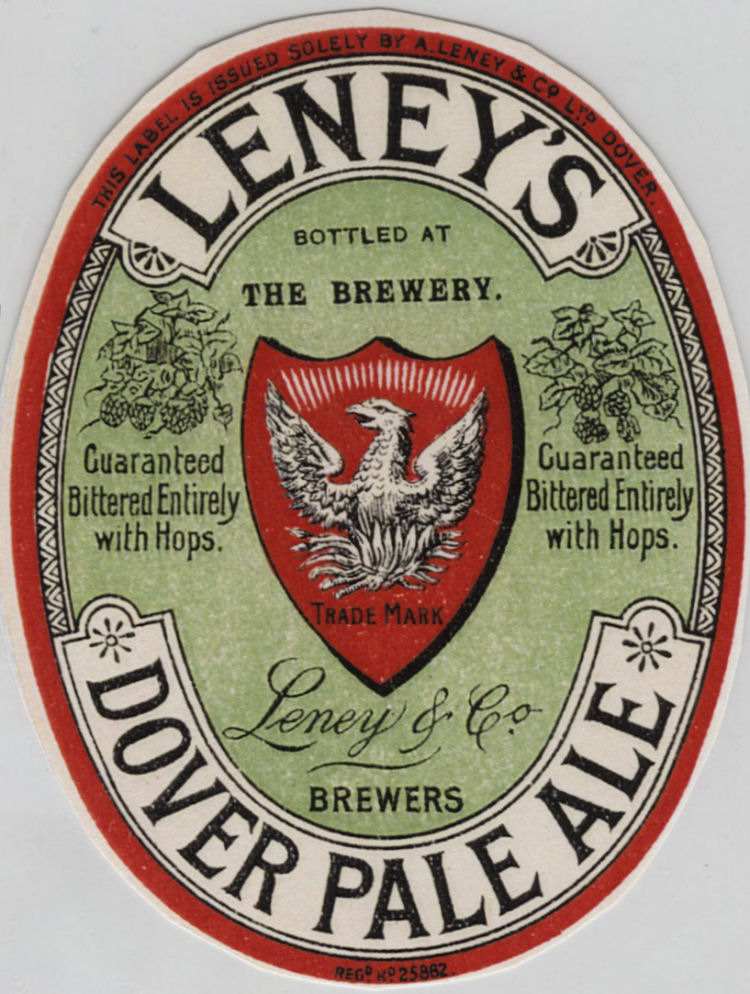 |
|
Leney's Dover Pale Ale label
|
Brewer
Leney's was a large and well known brewing company in Kent, famed for their
Kentish Ales and Stout. Alfred Charles's father, also Alfred, bought the
Phoenix brewery in Dolphin Lane, Dover, along with about thirty "tied
houses" in 1859, and was eventually joined in the business by his
three sons, Alfred Charles, Hugh and Frank. Alfred (senior) died in 1900,
but the business continue to flourish and in 1904 took over the rival firm
of Flint & Co. of St Dunstan’s Brewery, Canterbury. It is thought that
Leney & Co., after their absorption of Flint & Co., owned about 160
tied premises, mainly in East Kent and the Rye and Hastings area of East
Sussex. In 1926 the firm of Alfred Leney & Co. amalgamated with Fremlin
Brothers of Maidstone to form the public company known as Fremlins Ltd., and
Alfred Charles Leney became the first Chairman of the new company.
Brewing at Dover ceased in 1927 but bottling of beer continued until 1950 at
the Phoenix Brewery, the beer being transported from the Fremlins brewery at
Maidstone. After bottling ceased the old brewery was used as a distribution
depot by Fremlins until its demolition in 1963. In the late 1960s Fremlins
was itself taken over by the brewing giant Whitbread.
Alfred served briefly as a volunteer in the 1st Cinque Ports Artillery
Volunteer Corps, commissioned as a second lieutenent on 1 December 1877 (London
Gazette 30 November 1877 p6894) and resigning that commission
on 26 March 1879 (London Gazette 26 March1879 p2382)
Alfred was appointed High Sheriff of Kent for 1933 (London Gazette 17 March 1933 p1856).
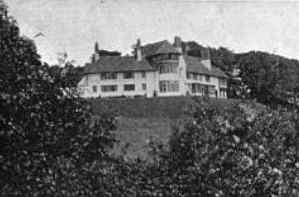 |
|
"The Garden House", Saltwood, Kent, was
situated on 26 acres commanding good sea views
|
Alfred and Bertha's house, "The Garden House" in Saltwood was aptly named.
The beauty and variety of the garden was featured in a number of
publications at the time, such as Beautiful Gardens, how to Make and Maintain Them
(Walter Page Wright, 1907) and Flower Grouping in English, Scotch & Irish Gardens
p146 (Margaret H. Waterfield, 1907)
17 November 1953, in Folkestone
district, Kent, England, aged 93
1871: St John the
Baptist, Margate, Kent
1881: London
Road, Buckland, Kent
1891: Waterloo
Crescent, St James the Apostle, Kent
1901: Salisbury
Road, Dover, Kent
1911: Saltwood, Kent: Alfred C. Leney, head, is aged 50, born in Dover, Kent
1916: Garden House, Saltwood, Hythe, Kent (London Gazette 6 June 1916 p5669)
1933: The Garden House, Saltwood, Hythe, Kent (London Gazette 17 March 1933 p1856)
1953: Rhodes House, Sellindge, near Ashford, Kent (London Gazette 5 January 1954 p199)
Naomi Hulke (Leney, Samuelson) Pearson
7 January 1890, in Dover, Kent,
England
6 February 1890, in St James,
Dover, Kent, England
Alfred Charles
Leney
Bertha
Backhouse (Hulke) Leney
Guy Weston Samuelson on 2
April 1913, in St
George Hanover Square district, London, England
Guy was born on 15 December 1890, in Kensington
district, London, the son of Godfrey Blundell Samuelson and Annie Jane
Davis. He was educated at Radley College, Oxfordshire and was an army
officer commissioned as a second lieutenant in the 4th Battalion, Alexandra,
Princess of Wales's Own (Yorkshire Regiment) on 1 June 1910 (London Gazette 24 June 1910 p4491),
promoted to lieutenant on 1 May 1914 (London Gazette 2 June 1914 p4385), then to
captain on 13 May 1915 (London Gazette 8 June 1915 p5522). Guy
resigned his commission on 10 July 1920, retaining the rank of captain (London Gazette 9 July 1920 p7418). After
his divorce from Naomi, Guy married Frances Crawley Lyne on 9 December 1927,
in Newton
Abbot district, Devon. He served in World War II in the Royal Air
Force Reserve, commissioned on 5 November 1940 as a pilot officer in the
Administrative and Special Duties Branch, on probation for the duration of
hostilities (London Gazette 14 March 1941 p1528), later
confirmed in the rank (London Gazette 30 December 1941 p7358) and
transferred to the R.A.F. regiment as a flying officer on 1st February 1942
(London
Gazette 30 June 1942 p2885), but relinquished his commission
on account of ill-health on 14 June 1943, retaining the rank of flight
lieutenant (London Gazette 6 July 1943 p3045). Guy died
in 1973 in Tiverton
district, Devon.
Census:
1891: Apsley
House, Meadfoot Road, Tormoham, Devon
1901: Osborne Road, New Windsor: Guy W. Samuelson, pupil, is aged 10, born
in London
1911: Petham, Kent: Guy Weston Samuelson is aged 20, born in London
- Rowland Guy Blundell Samuelson (1914 - ? )
Naomi and Guy were divorced.
 |
|
Algernon George Pearson
|
Algernon George Pearson in
1947, in Folkestone
district, Kent, England
Algernon was born on 28 June 1889, in Pwllheli
district, Caernarvonshire, Wales, the son of George Frederick Pearson
and Marion de Hauteville Bell, and baptised on 22 August 1889, in Denio,
Caernarvonshire. He was educated at Uppingham
School and Trinity
College, Cambridge. Algernon was commissioned as a second lieutenant
on 12 January 1912, and placed on the unattached list for the Territorial
Force (London Gazette 26 January 1912 p650), then
transferred to the Pricess Charlotte of Wales's (Royal Berkshire Regiment)
on 7 August 1912, although carrying seniority from 19 September 1911 (London Gazette 6 August 1912 p5856). He
resigned his commission on 5 March 1913 (London Gazette 4 March 1913 p1635) to be
promoted to lieutenant in the special reserve of officers in regiment's 3rd
battalion on 9 April 1913 (London Gazette 8 April 1913 p2534), then
seconded to the Staff and appointed aide-de-camp on 5 August 1914 (London Gazette 28 August 1914 p6885).
Algernon was promoted to captain, remaining seconded, on 1 November 1915 (London
Gazette 7 December 1915 p12200). On 2 August 1916, Captain
Pearson was seconded to the Machine Gun Corps (Infantry) (London Gazette 17 November 1916 p11159) and
the Machine Gun Corps (Heavy) on 20 November 1916 (London Gazette 22 December 1916 p12486). He
was promoted to temporary major on 1 March 1917 (London Gazette 27 April 1917 p4050). The
Heavy Branch of the Machine Gun Corps became the Tank Corps on 27 July 1917.
In 1918, Algernon was awarded the Distinguished Service Order for his action
in command of 'H' Battalion's capture of the village of Fontaine (London Gazette 15 February 1918 p2156).
London Gazette 18 July 1918 p8442
AWARDED THE
DISTINGUISHED SERVICE ORDER.
Capt. (T./Maj.) Algernon George Pearson, R. Berks. R., Spec. Res., and
Tank Corps.
For conspicuous gallantry and devotion to duty. He launched a
successful attack with his tanks at very short notice, captured a
village in the enemy's lines, held it until the infantry established
themselves in the position, and brought his tanks safely out of action.
He showed the greatest ability and courage in a most difficult
operation. He again led his tanks into action two days later with
excellent results.
Further details of the action are found in a
biography
of Algernon Pearson at DNW Auctions
Early on the morning of the 21st, orders were received for 24th Company
to join a Composite Battalion from the 2nd Brigade under the command of
Colonel Bryce for operations against the Containg-Fontaine Line, and
Major Pearson at once moved forward his tanks to a spot about 1,000
yards N.E. of Flesquieres. The infantry of the 154th Brigade had been
held up by machine gun fire and uncut wire on the western outskirts of
Containg Village, and until the arrival of the tanks, were unable to
make further progress.
The appearance at 3:30p.m. of 6 tanks of 24th Company at once brought
relief to the harassed Gordon Highlanders, who were attacking this
position. The enemy’s machine guns were quickly silenced and the Germans
retired in Great disorder, leaving a large number of prisoners in the
hands of their assailants. A large trench mortar firing from a concrete
emplacement in Containg Mill, was put out of action by the tanks, which
then proceeded to clear out the village itself. On the northern edge a
trench full of the enemy was effectually dealt with, the garrison
retreating hastily under heavy fire from the guns of the pursuing tanks.
Algernon was appointed as a General Staff Officer 3rd grade, and
relinquished his temporary rank of major, on 16 April 1918 (London Gazette 31 May 1918 p6345). He
relinquished that appointment on 27 February 1919 (London Gazette 17 June 1919 p7775).
Algernon married Edith Sylvia Craven, in 1915 in Sunderland
district, Durham. Sylvia died on 10 February 1847, at Lavender
Cottage, Littlestone-on-Sea, Kent. Algernon died on 5 July 1962, in Ashford
district, Kent, aged 73.
Who's Who, 1935 p2600
PEARSON,
Captain Algernon George, D.S.O. 1918; b. 28 June 1889; s.
of late George Frederick Pearson and late Marion de Hauteville Pearson;
m. 1915, E. Sylvia Craven; two
s. one d.
Educ.: Uppingham; Trinity
College, Cambridge, B.A. University Commission into Royal Berkshire
Regt., 1911; served European War, 1914-18 (despatches, D.S.O.).
Address: Aldington, Kent. Clubs: Bath; St. Andrews; St.
George’s.
Census & Addresses:
1891: Clarendon
Road, Watford, Hertfordshire
1911: St Marylebone, London; Algernon George Pearson is aged 21, born in
Pwllheli, Caernarvonshire, Wales
1947: The Dormy House, Littlestone-on-Sea, Kent (Kenya Gazette 4 November 1947 p604)
1962: East Brabourne House, Ashford, Kent (London Gazette 24 July 1962 p5956)
The
Strad May 1902 p5
On
Thursday afternoon, at Wampach's Hotel, an enjoyable concert was given
by the Misses FOSTER-EVANS and their
pupils, assisted by Miss E. Pender-Cudlip, Miss Enid Lloyd-Jones, and
Mr. Bertram Hudson. The first part of the programme was devoted
exclusively to the instrumental recitals of the pupils. “Petite Suite,”
two violins and violoncello was played by Miss Dorothy Brooke-Hunt, Miss
Ida Kerr, and Miss Naomi Leney. A violin solo, “Benedictus,” was given
by Miss G. Ley-Bazeley ; a violoncello solo, “Romanze,” by Miss May
Cooper ; and a violin solo, “Romanze,” by Miss Elsie Birch. Handel's
sonata Trio in A for two violins and violoncello, was effectively given
by Miss G. Ley-Bazeley, Mr. F. Higham, and Miss Cooper. The performances
of the pupils gave evidence of careful tuition, and the brilliant
rendition of the second part of the programme was a model and
inspiration for the pupils to follow.
5 August 1969, in Battle
district, East Sussex, England
1891: Waterloo
Crescent, St James the Apostle, Kent
1901: Earl's
Avenue, Folkestone, Kent
1911: Saltwood, Kent: Naomi Hulke Leney, daughter, is aged 21, born in
Dover, Kent
1955: Coolville House, Clogheen, county Tipperary (Dover Express 18 November 1955)
1969: Holly House, Wye, Ashford, Kent (London Gazette 16 March 1971 p2378)
Ruth (Leney) Grubb
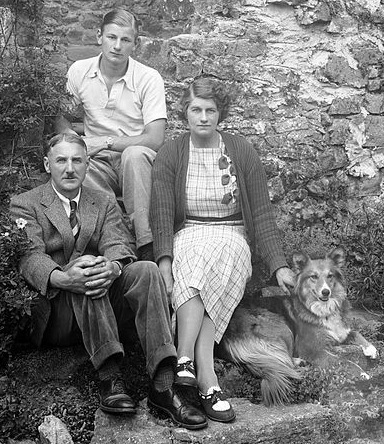 |
|
Richard Raymond de Cruce Grubb and Ruth
(Leney) Grubb and son at at Castle Grace, Clogheen, county
Tipperary (15 August 1937).
The photograph is taken just a few weeks after the death of their
elder son, Richard, in a flying accident.
|
6 November 1893, in Dover, Kent,
England
5 December 1893, in Charlton near
Dover, Kent, England
Alfred Charles
Leney
Bertha
Backhouse (Hulke) Leney
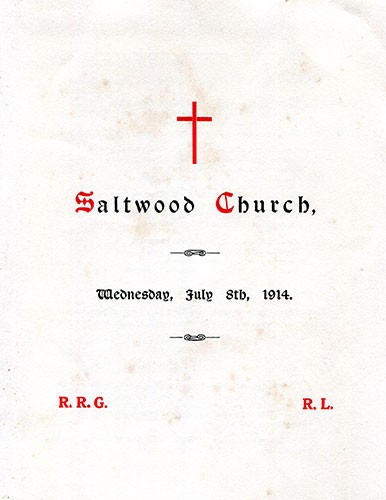 |
|
Wedding programme for the marriage of Ruth
Leney and Richard Raymond de Cruce Grubb
|
Richard Raymond de Cruce Grubb on 8
July 1914, in Saltwood church, Kent, England
The wedding was described in the diary
of Winona Rosalie ‘Jess’ Armstrong:
It rained nearly all morning. Muz & I went
down the town, then went round, to the car. Then we went off to Ruth Leney
& Captain Grubb’s wedding, over at Saltwood. It cleared up in the
afternoon, & was lovely & warm. The Bridesmaids had yellow &
blue bouquets, & white dresses. We looked at the presents & then
came home.
London
Times 6 August 1913
MR. R. R. DE C
GRUBB AND MISS LENEY
A marriage has been arranged between Richard Raymond de Crucy Grubb, 3rd
King's Own Hussars, only son of Mr. and Mrs. S. R. Grubb, of Castle
Grace, Co. Tipperary, and Ruth, younger daughter of Mr. and Mrs. Alfred
C. Leney, of The Garden House, Saltwood, Kent.
Richard was born on 11 June 1886, in Clogheen, county Tipperary, the son of
Samuel Richard Grubb and Alice Hannah Binney. He was educated at Wellington
College, Berkshire and the Royal Military College, Sandhurst. He was an army
officer commissioned as a second lieutenant in the 3rd (King's Own) Hussars
on 16 August 1905 (London Gazette 15 August 1905 p5619) and
promoted to lieutenant on 10 February 1907 (London Gazette 28 May 1907 p3668). He was
appointed adjutant on 12 January 1911 (London Gazette 13 January 1911 p320),
promoted to captain on 12 January 1914 (London Gazette 23 January 1914 p602) and
seconded to the Royal Military College on 10 August 1914 as an officer of a
company of Gentleman Cadets (London Gazette 28 August 1914 p6795),
holding that appointment until 9 October 1915 (London Gazette 12 October 1915 p10110). On
27 November 1915, Richard was appointed as a staff officer in the Royal
Flying Corps (London Gazette 7 January 1916 p342) and
attached to headquarters units as a brigade
major on 30 January 1916 (London Gazette 22 February 1916 p2085),
then appointed to the General Staff as a G.S.O., 2nd Grade, on 26 October
1916 (London Gazette 21 November 1916 p11385).
Richard was awarded the Military
Cross on 1 January 1917 (Edinburgh Gazette 1 January 1917 p35), and
promoted to brevet
major as a reward for distinguished service on 1 January 1918 (London Gazette 28 December 1917 p12).
Richard was restored to the establishment of the 3rd Hussars on 5 July 1920
(London Gazette 20 July 1920 p7747),
promoted to major on 2 April 1921 (London Gazette 12 April 1921 p2968) and to
lieutenant-colonel on 18 June 1932 (London Gazette 12 July 1932 p4559). On 18
June 1936, on completion of his period of service in command, Richard was
promoted to colonel and placed on the half pay list (London Gazette 19 June 1936 p3920). He
became on Instructor (Class Y) in the Senior
Officers' School, then appointed G.S.O. 1st Grade on 16 November 1937
(London
Gazette 16 November 1937 p7186), relinquishing that
appointment on 10 January 1938 and returning to the half pay list (London Gazette 11 January 1938 p192) and
retiring a few days later on 15 January 1938 (London Gazette 14 January 1938 p290). On 11
June 1946, Richard attained the age limit of liability to recall and ceased
to belong to the Reserve of Officers (London Gazette 26 July 1946 p3883). Richard
died on 28 December 1970 at Castle Grace, Clogheen, county Tipperary.
London
Times 29 December 1970
GRUBB -
On December 28th, 1970, Richard Raymond de Cruce Grubb, peacefully at
Castle Grace, Clogheen, co. Tipperary, late Col., 3rd Hussars, beloved
husband of Ruth. Funeral strictly private.
Census:
1901:
Castlegrace, Tullaghorton, Clogheen, county Tipperary
1911: Roberts Heights, Transvaal, South Africa: Richard Raymond De Cruce
Grubb is single, aged 24, born in Clogen Cahir. He is in the 3rd K. O.
Hussars.
- Richard de Cruce Grubb (1915 - 1937)
Ruth was the bridesmaid at the weeding of her uncle, Frank Leney, to Nora
Hale in 1900.
Whitstable
Times and Herne Bay Herald 5 May 1902 p5
MARRIAGE OF MR. FRANK LENEY
PRETTY CEREMONY AT LANCASTER GATE.
On Thursday last, at Christ Church, Lancaster-gate, the marriage
took place of Mr. Frank Leney, youngest son of Mr. Alfred Leney, of
Buckland House, Dover, and Miss Nora Florence Hale, younger daughter of
Mr. John H. Hale, of 16. Lancaster-gate, W.
The bride, who was given away by her father, wore a dress of
white satin duchesse, embroidered with pearls and silver, trimmed
handsomely with old Brussels lace and orange blossoms. She had a full
court train of embroidered and open work Roman satin, trimmed
elaborately with chiffon and ruches, and lined with white silk gauze.
She had also some magnificent orange blossoms in her hair, and wore an
embroidered tulls veil. Her bouquet consisted of white orchids, lilies
of the valley, orange blossom and white heather, this and her diamond
pendant being the gifts of the bridegroom. Her train was carried by Miss
Ruth Leney (niece of the bridegroom), who wore a dainty little soft
white satin frock, transparent yoke of lace and chiffon fichu, and a
white fancy straw hat trimmed with white plumes and chiffon. The nine
bridesmaids were:- Miss Hale (sister of bride). Miss Irene Churchill
(cousin of bride). Miss Marjorie Fremlin cousin of bridegroom), Miss
Evans, Miss Elliott Cooper, Miss Gladys Cornfoot, Miss Crossley, Miss
Nicholson, and Miss Olive Barron. They were attired in white silk gauzo
gowns, made over pale blue silk and chiffon, trimmed with corn appliqué
lace and insertion; and wore hats of pale blue straw trimmed with ecru
chiffon and insertion and white plumes and quills, and carried bouquets
of Catherine Mermet roses and lilies of the valley. These and diamond
"Merry Thought" brooches were the gifts of the bridegroom.
The officiating clergy were the Rev. Prebendary Ridgeway, vicar
of the parish, assisted by the Rev. Grevile-Marius-Livett, vicar of
Wateringbury, brother-in-law of the bridegroom. The service was fully
choral, and the church was handsomely decorated with palms and white
flowers.
Major Banks, of Oxney Court, near Dover, acted as best man. The
bride's mother wore a gown of light Pastle blue voile embroidered in
self colours, and trimmed with lace and Pastle chiffon. A smart toque to
correspond with shaded pink roses was worn with this toilette. The
bride's going away dress was a pale grey voile robe embroidered in
white, trimmed with white satin and lace, and she wore a white carolina
straw hat, lined with white chiffon, and trimmed with ostrich pluses,
chiffon and pink carnations.
The reception was held at the residence of the bride's parents,
16, Lancaster-gate, and later in the afternoon Mr. and Mrs. Frank Leney
left for Paris and the Italian Lakes, where the honeymoon is being
spent.
The presents numbered over 200, and included a handsome silver
engraved salver from the employees of Alfred Leney and Co., Limited.
4 June 1980, at Castle Grace,
Clogheen, county Tipperary, Ireland
1901: Salisbury
Road, Dover, Kent
1911: Saltwood, Kent: Ruth Leney, daughter, is aged 17, born in Dover, Kent
1955: Castle Grace, Clogheen, county Tipperary (Dover Express 18 November 1955)
Return to Chris Gosnell's Home Page
If you have any comments, additions or modifications to the information on this page, please feel free to email me.
Created and maintained by: chris@ocotilloroad.com







